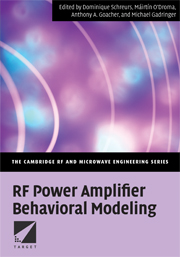Book contents
- Frontmatter
- Contents
- Notation
- Abbreviations
- Preface
- 1 Overview of power amplifier modelling
- 2 Properties of behavioural models
- 3 Memoryless nonlinear models
- 4 Nonlinear models with linear memory
- 5 Nonlinear models with nonlinear memory
- 6 Validation and comparison of PA models
- 7 Aspects of system simulation
- Appendix A Recent wireless standards
- Appendix B Authors and contributors
- Index
3 - Memoryless nonlinear models
Published online by Cambridge University Press: 06 January 2010
- Frontmatter
- Contents
- Notation
- Abbreviations
- Preface
- 1 Overview of power amplifier modelling
- 2 Properties of behavioural models
- 3 Memoryless nonlinear models
- 4 Nonlinear models with linear memory
- 5 Nonlinear models with nonlinear memory
- 6 Validation and comparison of PA models
- 7 Aspects of system simulation
- Appendix A Recent wireless standards
- Appendix B Authors and contributors
- Index
Summary
Introduction
In this chapter we focus on memoryless nonlinear power amplifier behavioural models for use in transmitter or full communications-channel system simulations. Static envelope characteristics, i.e. static AM–AM and AM–PM characteristics, are the basis for defining a behavioural model as memoryless.
Memoryless behavioural modelling has been used for many years because of its generally easier computational implementation, its relative efficiency in system simulations and its acceptable level of accuracy in many situations. Historically, this approach has found particular favour in predicting intermodulation distortion problems in the robust multicarrier travelling-wave tube amplifiers (TWTAs) used in communication satellite transponders. Travelling-wave tube amplifiers are inherently wideband devices, with a bandwidth of e.g. 500 MHz, and have a near-constant group delay. Any memory-like effects will be those introduced by the channelising demultiplexers on the input, which mainly result in multipath and crosstalk effects, and by the zonal filters that are used on the output to remove especially harmonics but also out-of-band intermodulation products (IMPs). Generally these amplifiers operate under stable temperature conditions, even if the satellites themselves are subject to large temperature variations. The simultaneous multiple air-interface multicarrier configuration of many of these transponder amplifiers is complex by comparison with the single-carrier solid-state power amplifiers (SSPAs) encountered in mobile handsets and the like. In recent years, however, the use of air interfaces based on multicarrier modulation schemes (e.g. orthogonal frequency-division multiplex, OFDM) has grown because of their excellent spectral efficiency and reduced susceptibility to multipath fading. But the simultaneous common nonlinear power amplification of multiple air-interfaces, the parallel of the multicarrier satellite transponder, is not yet normal in SSPA applications.
- Type
- Chapter
- Information
- RF Power Amplifier Behavioral Modeling , pp. 86 - 135Publisher: Cambridge University PressPrint publication year: 2008
- 3
- Cited by

